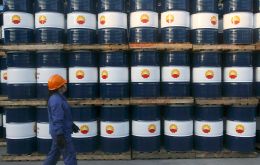MercoPress. South Atlantic News Agency
Tag: Brent
-
Monday, September 5th 2022 - 18:31 UTC
OPEC to cut down oil output to keep price stable

The Organization of Oil Exporting Countries (OPEC) Monday decided to cut their output of crude and put on sale on international markets 100,000 bpds less daily as fears of a recession keep bringing down the price of crude.
-
Friday, May 22nd 2020 - 08:41 UTC
Oil prices slump after China omits 2020 economic growth target

Oil prices slumped on Friday after China's decision to omit an economic growth target for 2020 renewed concerns that the fallout from the coronavirus pandemic will continue to depress fuel demand in the world's second-largest oil user.
-
Monday, April 20th 2020 - 07:39 UTC
US oil falls to below US$ 15 a barrel and Brent dropped to US$ 27

US crude fell about 20% to below US$15 a barrel on Monday, its lowest level in about two decades, as a coronavirus-triggered collapse in demand eclipsed a deal to cut output. West Texas Intermediate, the US benchmark, fell 18.7% to US$14.84 a barrel. Brent crude, the international benchmark, was off 1.5% at US$27.64 a barrel.
-
Wednesday, March 11th 2020 - 08:49 UTC
Oil prices with slight recovery on Tuesday but market volatility remains

Oil, which plunged about 25% on Monday, rebounded on Tuesday along with equities and other financial markets. Brent futures rose US$2.69, or 7.8%, to US$37.05 a barrel by 2:24 p.m. EDT (1824 GMT), while U.S. West Texas Intermediate (WTI) crude rose US$2.73, or 8.8 percent, to US$33.86.
-
Monday, January 7th 2019 - 09:03 UTC
Oil Is at the mercy of Financial Markets

Oil prices regained more ground on Wednesday, pushed higher after equity markets rebounded from an initial selloff at the start of 2019 trading. The price gains are not entirely convincing. WTI and Brent posted strong gains, each up more than 3 per cent by midday in New York, but come largely after U.S. equity markets shook off an earlier bout of pessimism.
-
Monday, December 3rd 2018 - 07:18 UTC
Oil prices recover following on US/China trade conflict 90-day truce

Oil prices surged in early trading on Monday after the United States and China agreed on a truce in their trade conflict and ahead of a meeting by producer club OPEC this week that is expected to result in a supply cut.
-
Thursday, October 4th 2018 - 07:04 UTC
Oil hits new high ahead of US sanctions on Iran supply, and despite Russia and Saudi higher production

Brent crude rose nearly 2% after hitting a four-year high on Wednesday as the market focused on upcoming U.S. sanctions on Iran while shrugging off the year’s largest weekly build in U.S. crude stockpiles and reports of higher Saudi Arabian and Russian production.
-
Tuesday, September 25th 2018 - 07:45 UTC
Oil market turbulence ahead of US sanctions on Iran; OPEC meeting does not plan to increase output

Brent crude breached US$ 81 a barrel on Monday — its highest level in nearly four years — on the back of a tightening oil market and OPEC leaders signaling they won't be immediately boosting output. Global benchmark Brent crude rose as high as US$ 81.39 a barrel, its strongest level since Nov. 21, 2014.
-
Saturday, December 5th 2015 - 06:50 UTC
Oil futures fall sharply after OPEC agrees to keep 'current actual production'

Oil futures fell sharply Friday, with the U.S. benchmark settling below $40 a barrel after the Organization of the Petroleum Exporting Countries agreed to keep pumping crude at current production levels despite a global glut.
-
Wednesday, November 25th 2015 - 08:33 UTC
Commodities prices hovering at 13-year lows; metals suffered the most

Commodities hit 13-year lows on Monday as metals markets crashed but a steady close in oil and higher grains markets helped a key sector benchmark settle off the day's trough. Copper and nickel prices fell to multi-year lows, forcing the Thomson Reuters/Core Commodity CRB Index to its lowest levels since November 2002.
